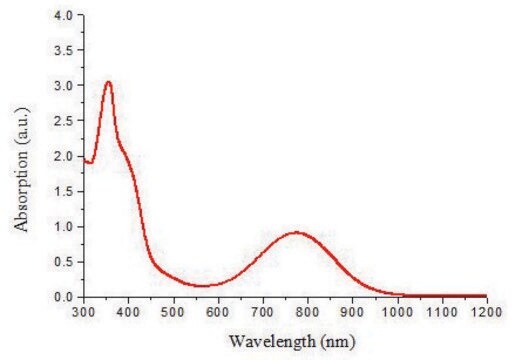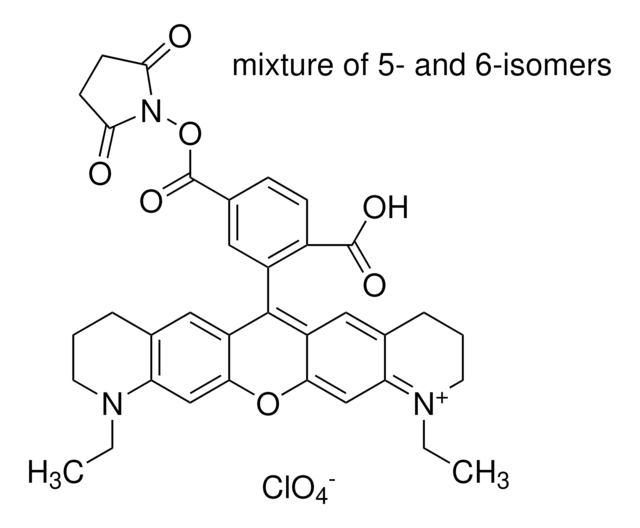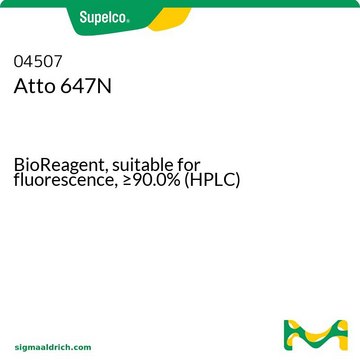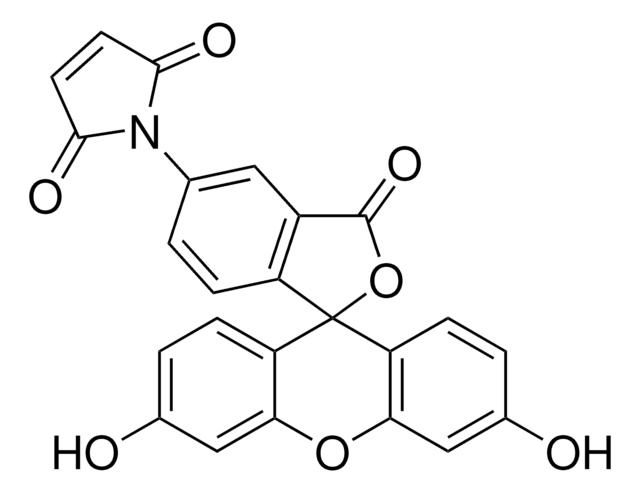Recommended Products
Assay
≥80% (coupling to thiols)
Quality Level
form
solid
manufacturer/tradename
ATTO-TEC GmbH
fluorescence
λex 619 nm; λem 643 nm in 0.1 M phosphate pH 7.0
suitability
suitable for fluorescence
storage temp.
−20°C
General description
Atto 620 belongs to a new generation of fluorescent labels for the red spectral region. The dye is designed for application in the area of life science, e.g. labelling of DNA, RNA or proteins. Characteristic features of the label are strong absorption, temperature dependent fluorescence, high thermal and photo-stability, good water
solubility, and very little triplet formation. Atto 620 is a cationic dye. After coupling to a substrate the dye carries a net electrical charge of +1. In common with most Atto-labels, absorption and fluorescence are independent of pH, at least in the range of pH 2 to 11, used in typical applications.
find more information here
solubility, and very little triplet formation. Atto 620 is a cationic dye. After coupling to a substrate the dye carries a net electrical charge of +1. In common with most Atto-labels, absorption and fluorescence are independent of pH, at least in the range of pH 2 to 11, used in typical applications.
find more information here
Packaging
Bottomless glass bottle. Contents are inside inserted fused cone.
Legal Information
This product is for Research use only. In case of intended commercialization, please contact the IP-holder (ATTO-TEC GmbH, Germany) for licensing.
Storage Class Code
11 - Combustible Solids
WGK
WGK 3
Flash Point(F)
Not applicable
Flash Point(C)
Not applicable
Certificates of Analysis (COA)
Search for Certificates of Analysis (COA) by entering the products Lot/Batch Number. Lot and Batch Numbers can be found on a product’s label following the words ‘Lot’ or ‘Batch’.
Already Own This Product?
Find documentation for the products that you have recently purchased in the Document Library.
Maria Strianese et al.
Journal of inorganic biochemistry, 104(6), 619-624 (2010-03-23)
In this paper we explore the use of fluorescently labeled cytochrome c peroxidase (CcP) from baker's yeast for monitoring nitric oxide (NO) down to the sub-micromolar level, by means of a FRET (Förster Resonance Energy Transfer) mechanism. The binding affinity
Maria Strianese et al.
Inorganic chemistry, 51(21), 11220-11222 (2012-10-18)
Fluorescently labeled cobalt peptide deformylase (Co-PDF) can be efficiently used as a fluorescence-resonance-energy-transfer-based sensing device for hydrogen sulfide (H(2)S). The proof of concept of our sensor system is substantiated by spectroscopic, structural, and theoretical results. Monohydrogen sulfide coordination to Co-PDF
Peter P T Surawski et al.
Molecular bioSystems, 4(7), 774-778 (2008-06-20)
The concept of optically encoding particles for solid phase organic synthesis has existed in the literature for several years. However, there remains a significant challenge to producing particles that are capable of withstanding harsh solvents and reagents whilst maintaining the
Darby Kozak et al.
Langmuir : the ACS journal of surfaces and colloids, 24(4), 1204-1211 (2007-12-11)
This study presents the use of flow cytometry as a high-throughput quantifiable technique to study multicomponent adsorption interactions between proteins and surfaces. Flow cytometry offers the advantage of high-throughput analysis of multiple parameters on a very small sampling scale. This
Our team of scientists has experience in all areas of research including Life Science, Material Science, Chemical Synthesis, Chromatography, Analytical and many others.
Contact Technical Service



